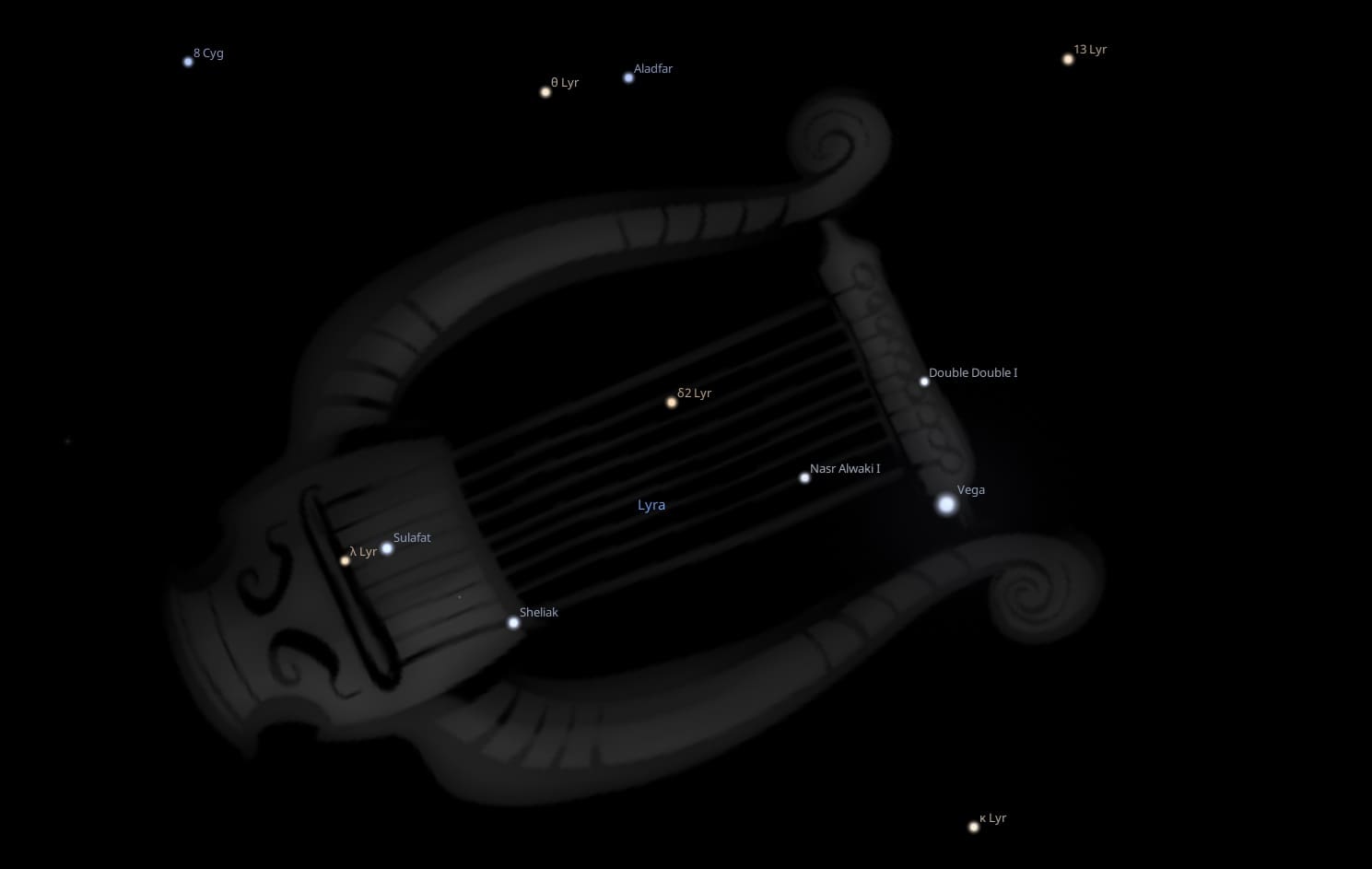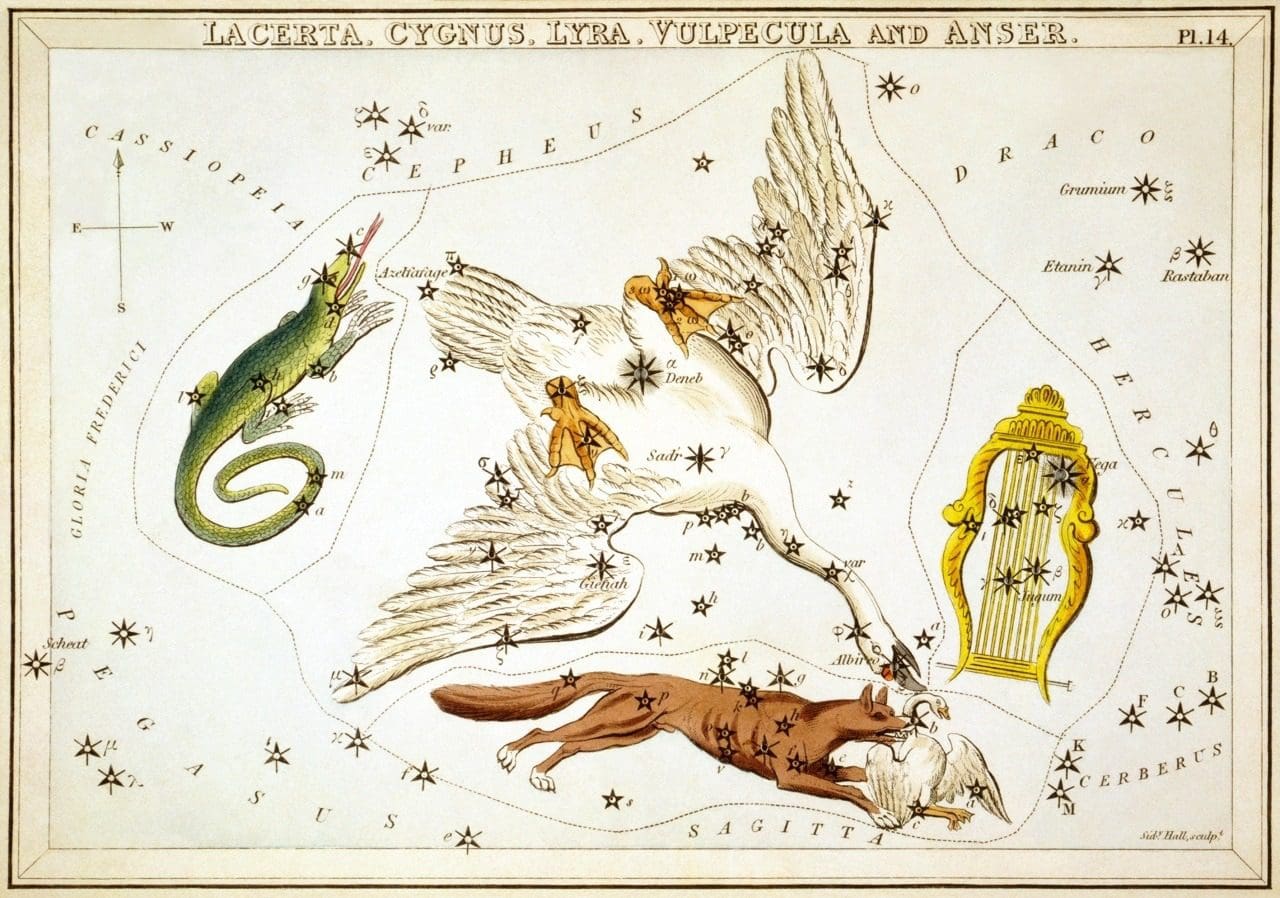FIXED STARS: Major Stars | 1000+ Stars | Constellations | About
Constellation Lyra the Harp is a northern constellation bordering Aquila, Hercules, Cygnus and the obsolete constellation Cerberus.Lyra is one of the 48 constellations listed by Ptolemy in the 2nd century and remains one of the 88 modern constellations. It spans 22 degrees of the zodiac in the Signs of Capricorn and Aquarius.
Lyra Constellation Stars
| 2000 | 2050 | Star | Name | Sp. Class | Mag. | Orb |
|---|---|---|---|---|---|---|
| 07♑53 | 08♑35 | κ Lyr | K2 | 4.33 | 1°10′ | |
| 10♑13 | 10♑55 | μ Lyr | Al Athfar | A3 | 5.11 | 1°00′ |
| 15♑19 | 16♑01 | α Lyr | Vega | A0 | 0.03 | 2°40′ |
| 18♑06 | 18♑48 | ζ1 Lyr | Nasr Alwaki I | A5 | 4.34 | 1°10′ |
| 18♑06 | 18♑48 | ζ2 Lyr | Nasr Alwaki II | F0 | 5.73 | 1°00′ |
| 18♑37 | 19♑18 | ε2 Lyr | Double Double II | A8 | 4.60 | 1°00′ |
| 18♑37 | 19♑19 | ε1 Lyr | Double Double I | F1 | 4.67 | 1°00′ |
| 18♑52 | 19♑34 | β Lyr | Sheliak | A8 | 3.52 | 1°40′ |
| 21♑55 | 22♑37 | γ Lyr | Sulafat | B9 | 3.25 | 1°50′ |
| 25♑13 | 25♑55 | R Lyr | M5 | 4.08 | 1°20′ | |
| 00♒03 | 00♒45 | η Lyr | Aladfar | B2 | 4.43 | 1°10′ |
| 00♒31 | 01♒13 | θ Lyr | K0 | 4.35 | 1°10′ |
Lyra Astrology
Manilius
and one may see among the stars the Lyre, its arms spread apart in heaven, with which in time gone by Orpheus charmed all that his music reached, making his way even to the ghosts of the dead and causing the decrees of hell to yield to his song. Wherefore it has honour in heaven and power to match its origin: then it drew in its train forests and rocks; now it leads the stars after it and makes off with the vast orb of the revolving sky.
Next, with the rising of the Lyre, there floats forth from Ocean the shape of the tortoise-shell testudinis, which under the fingers of its heir gave forth sound only after death; once with it did Orpheus, Oeagrus’ son, impart sleep to waves, feeling to rocks, hearing to trees, tears to Pluto, and finally a limit to death. Hence will come endowments of song and tuneful strings, hence pipes of different shapes which prattle melodiously, and whatever is moved to utterance by touch of hand or force of breath. The child of the Lyre will sing beguiling songs at the banquet, his voice adding mellowness to the wine and holding the night in thrall. Indeed, even when harassed by cares, he will rehearse some secret strain, tuning his voice to a stealthy hum and, left to himself, he will ever burst into song which can charm no ears but his own. Such are the ordinances of the Lyre, which at the rising of Libra’s twenty-sixth degree will direct its prongs to the stars. [1]
Robson
Legend. Mercury found the body of a tortoise cast up by the Nile, and discovered that by striking the sinews after the flesh was consumed a musical note was obtained. He made a lyre of similar shape, having three strings, and gave it to Orpheus, the son of Calliope, who by its music enchanted the beasts, birds and rocks. After Orpheus was slain by the Thracian women, Jupiter placed the lyre in heaven at the request of Apollo and the Muses. This constellation was often called Vultur Cadens, or the Falling Grype by the ancients.
Influence. According to Ptolemy Lyra is like Venus and Mercury. It is said to give an harmonious, poetical and developed nature, fond of music and apt in science and art, but inclined to theft. By the Kabalists it is associated with the Hebrew letter Daleth and the 4th Tarot Trump, “The Emperor.”
Magical. Preserves phrenetical and mad people. [2]
Noonan
The Lyre, or Lyra (Lyr), is an airy constellation that has a most marked influence on the weather, at least according to the classicists and the astrological principles of that era. Its stars traditionally have the nature of Venus and Mercury, but Venus and Jupiter would be a better representation according to the spectra of the brightest stars in the group. [3]
Allen
Lyra, the Lyre or Harp, anciently represented the fabled instrument invented by Hermes and given to his half-brother Apollo, who in turn transferred it to his son Orpheus, the musician of the Argonauts… Ovid mentioned its seven strings as equaling the number of the Pleiades… Still it has been shown with but six, and a vacant space for the seventh, which Spence, in the Polymetis, referred to the Lost Pleiad. Manilius seems to have made two distinct constellations of this, — Lyra and Fides, — although we do not know their boundaries, and the subject is somewhat confused in his allusions to it.
The association of Lyra’s stars with a bird perhaps originated from a conception of the figure current for millenniums in ancient India, — that of an Eagle or Vulture; and, in Akkadia, of the great storm-bird Urakhga before this was there identified with Corvus. But the Arabs’ title, Al Nasr al Waki’ — Chilmead’s Alvaka, — referring to the swooping Stone Eagle of the Desert, generally has been attributed to the configuration of the group alpha, epsilon, zeta, which shows the bird with half-closed wings, in contrast to Al Nasr al Ta’ir, the Flying Eagle, our Aquila, whose smaller stars, beta and gamma, on either side of alpha, indicate the outspread wings. Chrysococca wrote of it as kathemenos, the Sitting Vulture, and it has been Aquila marina, the Osprey, and Falco sylvestris, the Wood Falcon.
Its common title two centuries ago was Aquila cadens, or Vultur cadens, the Swooping Vulture, popularly translated the Falling Grype, and figured with upturned head bearing a lyre in its beak. Bartsch’s map has the outline of a lyre on the front of an eagle or vulture. Aratos called it Khelus olige, the Little Tortoise or Shell, thus going back to the legendary origin of the instrument from the empty covering of the creature cast upon the shore with the dried tendons stretched across it.
Lyra is on the western edge of the Milky Way, next to Hercules, with the neck of Cygnus on the east, and contains 48 stars according to Argelander, 69 according to Heis. Its location is noted as one of the various regions of concentration of stars with banded spectra, Secchi’s 3d type, showing a stage of development probably in advance of that of our sun. [4]
Lyra Constellation [Bullinger]
Bullinger
Its brightest star, α, is one of the most glorious in the heavens, and by it this constellation may be easily known. It shines with a splendid white lustre. It is called Vega, which means He shall be exalted. Its root occurs in the opening of the Song of Moses, quoted above. Is not this wonderfully expressive?
Its other stars, β and γ, are also conspicuous stars, of the 2nd and 4th magnitude. β is called Shelyuk, which means an eagle (as does the Arabic Al Nesr); γ is called Sulaphat, springing up, or ascending, as praise. In the Zodiac of Denderah, this constellation is figured as a hawk or an eagle (the enemy of the serpent) in triumph. Its name is Fent-kar, which means the serpent ruled. [5]
References
- Astronomica, Manilius, 1st century AD, book 1, p.30, book 5, p.327.
- Fixed Stars and Constellations in Astrology, Vivian E. Robson, 1923, p.50-51, 231.
- Fixed Stars and Judicial Astrology, George Noonan, 1990, p.17.
- Star Names: Their Lore and Meaning, Richard H. Allen, 1889, p.280-288.
- The Witness of the Stars, E. W. Bullinger, 1893, Lyra (the Harp).


